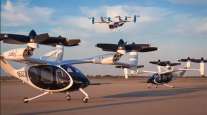Bloomberg News
Boeing Identifies New Software Problem on Grounded 737 Max

[Stay on top of transportation news: Get TTNews in your inbox.]
Boeing Co. engineers have discovered a new software problem on the grounded 737 Max that must be patched before the plane can return to service, Federal Aviation Administration chief Steve Dickson said.
Dickson confirmed during remarks in London on Feb. 6 that the agency is evaluating the issue. Boeing representatives didn’t immediately respond to a request for comment.
A light indicating that the stabilizer trim system wasn’t working properly “had been staying on for longer than a desired period,“ Dickson said, without providing more detail.
In part two of a two-part exploration of autonomous technology today, our latest RoadSigns podcast revisits conversations with Chuck Price of TuSimple and Ognen Stojanovski of Pronto.ai. Hear them discuss a palatable Level 2 version of trucking autonomy. Listen to a snippet above, and to hear the full episode, go to RoadSigns.TTNews.com.
Boeing shares seesawed during Dickson’s remarks. They rose after Dickson said a certification flight for the Max could occur in a few weeks, then pared gains following the disclosure by Bloomberg News of the new software problem. The stock climbed 2.9% to $339.24 at 11:32 a.m. in New York.
The issue involves an alert designed to warn when the so-called trim system, which helps raise and lower the plane’s nose, isn’t working properly, according to two people familiar with the issue who weren’t authorized to comment on it.
It’s not clear how much of a delay, if any, the issue will create as Boeing finalizes numerous fixes required to get its best-selling plane back into service. One of the people familiar with the trim alert problem said it’s not likely to change Boeing’s projection of returning the plane to service by mid-2020 because the company had built padding into its schedule.
The trim alert issue resulted from Boeing’s redesign of the two flight computers that control the 737 Max to make them more resilient to failure, the two people said.
Boeing last month announced it doesn’t expect the plane to fly again until the middle of the year. After months of missed deadlines and growing tension with the FAA, the company said it was projecting a timeline that included extra time in case new issues arose.
The company was already at work on a separate software system known as Maneuvering Characteristics Augmentation System that was involved in the two fatal crashes on the plane that killed 346 people and led to the grounding March 13.
Want more news? Listen to today's daily briefing:





